Google Promotes Maps and Local Listings With Decals and QR Codes
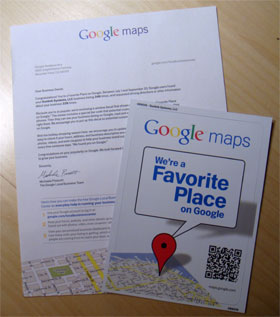 It’s not everyday that someone says you’re a favorite, especially when that someone is Google.
It’s not everyday that someone says you’re a favorite, especially when that someone is Google.
Yesterday I received a letter from Google’s Local Business Team regarding my Internet consulting firm, Dunkirk Systems, LLC. It stated my Google Local listing is a “Favorite Place of Google” and reinforced this with stats – it was viewed 346 times in the 3rd quarter of 2009. Along with this letter of praise came a window decal stating “We’re a Favorite Place on Google” which features a QR code with a link to the mobile version of my Google Local listing. If you have a QR code reader on your mobile device, click on the accompanying photo to see a larger version of it from which you can scan the QR code and navigate to the link, or view the link to my mobile listing in your Web browser.
Where I haven’t done any poking around to see who else got a similar letter, there is some value in this, and just the opposite. First off, Google Local listings work. I have been seeing the hits coming to the Dunkirk Web site from the Local listing in my Google Analytics reporting. It is also yet another way to drive traffic to you and your business. Google Local also gives the ability for people to rate a business, similar to Yelp, which also provides businesses with window stickers.
For a retail establishment, this is a great program to offer the window stickers. But for a business like mine, it isn’t something I can leverage. First off, my mailing address is different from my office location. And my office isn’t typically where I meet my clients or have walk-in traffic. But Google Local doesn’t know this, nor did they ask.
Legendary US Congressman and House Speaker Tip O’Neil is known for his quote, “all politics is local.” Can the same be said for search? Yes and no, with an emphasis on the word “and.” If you don’t have a Google Local listing for your business, set one up right away. Today, there’s many services offered by Google, at no cost, that businesses and Web sites must use. So it’s quite obvious I use them myself, and do business with Google in many ways. Whatever your opinion of them, keeping up with what is offered by the Internet giant is vital.
Business • Mobile Technology • QR Codes • Technology • (1) Comments • PermalinkWorking at OfficePort Chicago This Week
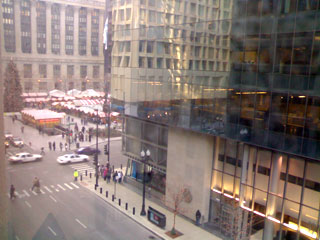 This week I am working at OfficePort Chicago. OfficePort is what’s referred to as a co-working environment, where anyone from entrepreneurs to small businesses can call OfficePort their own office.
This week I am working at OfficePort Chicago. OfficePort is what’s referred to as a co-working environment, where anyone from entrepreneurs to small businesses can call OfficePort their own office.
The folks at OfficePort offered me to try it for a week. I selected a “port” by the windows, and the accompanying photo is of the view from its location at 9 W. Washington Street in the Loop, which faces the CBS2/Morningstar building and has a view of the Christkindl Market at Daley Plaza. For the sake of full disclosure, OfficePort offered me the week to work here at no cost, and did not ask me to write anything about them, but I have been compelled to write this after being here a few days.
How is it? So far, so great! As my home working environment is just me in my windowless room, it is refreshing to have others around me, not to mention a view. I’ll sum up my experiences working at a OfficePort Chicago after the end of the week.
Did you enjoy reading this? You are welcome to subscribe to The Hot Iron by RSS feed or by email.
Make No Assumptions With Web Navigation
This sign came into my line of sight today, and it made me laugh. It also made me think about Web site architecture.
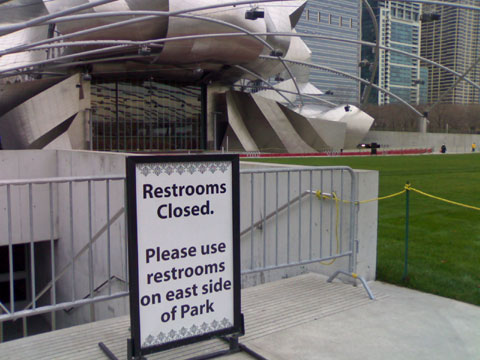
In this photo, which was taken in Chicago’s Millennium Park, you see a sign reading, “Restrooms Closed. Please use restrooms on east side of Park” and is in front of gates on a stairway by the Pritzker Pavilion. What made me chuckle was the assumptions made by whomever decided what would go on this sign, which include:
- The person reading it knows where they are
- The person reading it knows what direction they are facing
- The person reading it knows how to get to the east side
- The person reading it knows where on the east side of the park the restrooms are
- The person reading it knows English, but I’ll give them a pass on this one for now
What is also in the picture is the entrance to the restrooms on the east side of the park, which is to the far right of the red seats. Though they are so close, they are so far, especially when there usually isn’t anyone to direct you to where you are and where to go.
Similar Assumptions Made Online
Unfortunately assumptions of this sort are not exclusive to the offline world. Many times I find myself on a Web site and I have no idea how to get to where I want to go. I get more frustrated as I design and develop Web sites and I feel I should know how to get there.
This frustration is usually a result of the first assumption above, whomever designed the architecture and/or content of the Web site assumes the Web visitor has some knowledge of the entity or person the Web site is for. It can be as simple as the choice of words used in the navigation which may be unique to those “in the know” or it may mimic the offline structure of the entity.
So what can be done to prevent this? First off, knowing who your target audience is for your Web site is important. If you know who will be clicking around, you can design and develop to meet their expectations. Secondly, having an understanding of what your target audience is looking for will help in the presentation of this information. We always want to say what we want, and people are looking for what they are looking for. Finding the overlap in these expectations is where the magic happens, and makes the Web site successful. Finally, continuous review of the Web site’s analytics will tell you how successful you are doing. Many times designers and developers feel they must make something completely unique in their design. Where this surely shows their talent, true talent comes from creative design with high functionality.
If you go in with no assumptions and simply use hard data, you will be more successful in the end. And you also won’t be needlessly hunting around for a toilet in the Windy City.
Did you enjoy reading this? You are welcome to subscribe to The Hot Iron by RSS feed or by email.
Blog Post Titles Matter
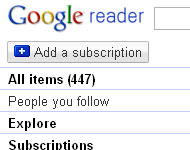 You set up your blog, you write frequently, you have a great subscriber base, so you’re done, right? Hardly. A blog is only as good as its most recent posts, and in order to keep people thinking you’re good they must be reading, and with every post you must compel them to do so, and it starts with the title.
You set up your blog, you write frequently, you have a great subscriber base, so you’re done, right? Hardly. A blog is only as good as its most recent posts, and in order to keep people thinking you’re good they must be reading, and with every post you must compel them to do so, and it starts with the title.
What’s Old Is New Again
The title of your blog post is like the headline of a news story in the newspaper. It must be true to the topic, yet have an element of sales to get someone to read it. Especially today, where people do not go out of their way to buy a newspaper and rather have a lot to choose from online, the title of the blog post has to resonate with them and be the entre to your writing.
It’s Not Just You
As the choices of what to read are almost limitless, coupled with the lack of attention span and overall time of the reader, people need to understand in seconds what your post is about and make a decision to read it or not. And in many cases, it has nothing to do with you personally, but moreso with your competition. Many people read blog posts with a blog feed aggregator such as Google Reader. If they go a few days – or even hours – without reading, the number of unread posts can quickly accumulate, as shown with the accompanying screen shot from my own Google Reader account. When faced with this, people will just scan headlines to get beyond the sheer number of posts and back to a manageable number for a later time. Your wonderful, thoughtful writing can be a victim of someone’s lack of time if it doesn’t catch their attention.
Where many times the headline comes first then the text of the post itself, before you go live with it, review the headline to see if it matches what you just wrote. If not, take a few seconds to adjust it, and this time invested may mean all the difference for someone else to take a few seconds to read what you wrote.
Did you enjoy reading this? You are welcome to subscribe to The Hot Iron by RSS feed or by email.
5 Years of Dunkirk Systems, LLC
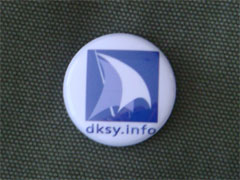 Today “technically” marks the 5 year anniversary of my consulting business, Dunkirk Systems, LLC. I say technically as it is the date of the filing of my incorporation of the business.
Today “technically” marks the 5 year anniversary of my consulting business, Dunkirk Systems, LLC. I say technically as it is the date of the filing of my incorporation of the business.
Where the true origins of my consultancy go back many, many years, the point where I decided to go on my own is in 2004, and it has been a wild ride from there for sure. On an almost daily basis I learn more about what it means to be in business – everything from operations to money to customer service. I have had the good fortune to work with some great people, from partners and contractors to clients.
So happy birthday Dunkirk, and it’s time to get back to work, as there is much more that lies ahead if we want to make it another 5 years!
Did you enjoy reading this? You are welcome to subscribe to The Hot Iron by RSS feed or by email.

